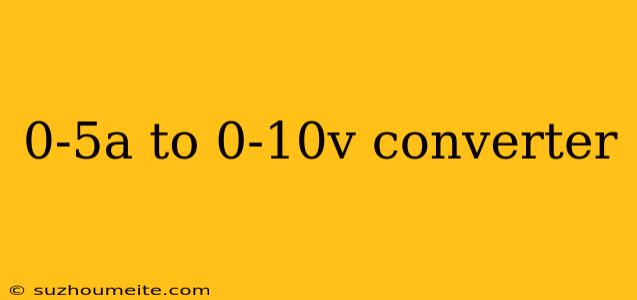0-5A to 0-10V Converter: Understanding the Basics and Applications
Introduction
In industrial automation, measurement, and control systems, there is often a need to convert signals from one form to another to interface with different devices or systems. One such conversion is from 0-5A to 0-10V, which is commonly used in industrial applications. In this article, we will explore the basics of 0-5A to 0-10V converters, their applications, and how they work.
What is a 0-5A to 0-10V Converter?
A 0-5A to 0-10V converter is an electronic device that converts a 0-5A current signal to a 0-10V voltage signal. This conversion is necessary when a device or system requires a voltage signal, but the input signal is in the form of a current signal. The converter ensures a safe and reliable transmission of the signal, maintaining the integrity of the data.
How Does a 0-5A to 0-10V Converter Work?
The working principle of a 0-5A to 0-10V converter is based on the concept of current-to-voltage conversion. The converter consists of a few key components:
- Current Sensor: This component measures the input current signal (0-5A) and converts it into a proportional voltage signal.
- Amplifier: The amplifier scales the output voltage signal from the current sensor to the desired range (0-10V).
- Voltage Regulator: This component ensures a stable output voltage signal, regulating any fluctuations or noise.
The converter's output is a linear, proportional voltage signal that corresponds to the input current signal.
Applications of 0-5A to 0-10V Converters
0-5A to 0-10V converters have a wide range of applications in various industries, including:
- Industrial Automation: In PLC-based systems, converters are used to interface with sensors, actuators, and other devices that require voltage signals.
- Process Control: Converters are used to measure and control process variables, such as temperature, pressure, and flow rate.
- Measurement and Testing: Converters are used in test and measurement equipment, such as multimeters and oscilloscopes, to measure and display current signals.
- Medical Equipment: Converters are used in medical devices, such as ECG machines, to convert current signals from sensors to voltage signals for display and analysis.
Conclusion
In conclusion, 0-5A to 0-10V converters play a crucial role in industrial automation, measurement, and control systems. By understanding the basics and applications of these converters, engineers and technicians can design and implement more efficient and reliable systems. Whether it's for process control, measurement, or medical equipment, a 0-5A to 0-10V converter is an essential component in ensuring accurate and reliable signal transmission.
